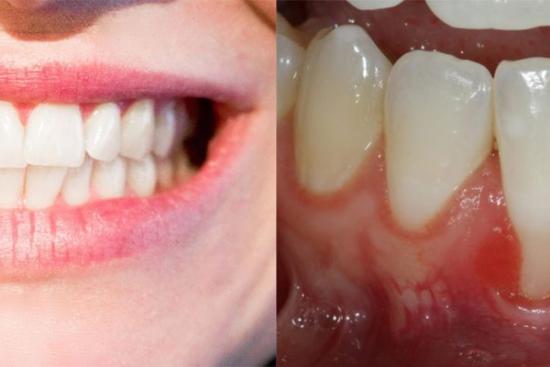Gum grafting is a surgical procedure in which a sample of gum tissue is taken from the palate or gum ridge where teeth are missing. This tissue is then transplanted to increase the thickness of the gums or to cover gum recession.
Turquie Santé provides access to top-notch dental facilities. Reach out to us for a complimentary quote on your gum graft in Turkey.
- Patients with gum recession
- Patients with tooth sensitivity or aesthetic concerns
- Patients with gum disease
- Pain and discomfort
- Swelling and bruising
- Graft failure
- Bleeding
- Orthodontic treatment
- Scaling and root planing
- From 30 minutes to 2 hours
Gum graft cost in Turkey
Our partner clinics offer experienced periodontists who can perform gum grafting in Turkey at a significantly lower and affordable cost than in many other countries. This makes it a cost-effective option for restoring healthy gums, preventing further complications, and achieving a more aesthetic smile.
On average, the gum graft cost in Turkey is between €500 and €1,500. These prices are only estimates and may vary from case to case.
Turquie Santé will make sure you get the best quality care at the lowest prices at one of our dental hospitals or clinics in Istanbul, Izmir, Ankara, and Antalya, Turkey.
Best Clinics with Verified Reviews

- Renowned specialty dental clinic
- 12 examination rooms
- 26 specialized dentists on an area of 2,000 m2

- Specialised dental clinics in Istanbul
- 40 examination rooms
- 60 dentists in total area of 4.000 m2
Indications for gum grafting
Gum grafting can be performed in Turkey to correct a variety of problems, including:
- Gum recession: This is a condition in which the gums pull away from the tooth, exposing the root. This can be caused by periodontal disease, over-aggressive brushing, or improper flossing.
- Gum defects: These are areas where the gums are missing or too thin. This can be caused by periodontal disease, injury, or congenital abnormalities.
- Exposed root coverage: When the gums shrink, the roots of the teeth can become exposed. This can make teeth sensitive to hot and cold, and can also increase the risk of tooth decay.
Types of gingival graft
There are three main types of gingival graft: connective tissue graft, free gingival graft, and pedicle graft.
Types of gingival grafts | Characteristics |
Connective tissue grafts | Connective tissue grafting involves removing tissue from the roof of the mouth and placing it over the exposed tooth root to cover gingival recession. This type of grafting is often used to treat root exposure and improve gingival aesthetics. |
Free gingival grafts | Free gingival grafting involves taking tissue from the roof of the mouth and attaching it to the receding gums. This type of graft is usually used to increase the thickness of the gum tissue and provide more support for the teeth. |
Pedicle grafts | Pedicle grafts involve taking tissue from the gum around the tooth being repaired and placing it over the exposed root. This type of graft is suitable for people who have a lot of gum tissue near the affected area and can help effectively cover the exposed root. |
Each type of gum graft has its advantages and is chosen according to the patient's specific needs.
You can consult a periodontist or dentist in Turkey to determine which gum grafting procedure is best for your specific condition.
Preoperative preparation for a gum graft
Before gum graft surgery, it's important to take certain steps to ensure a smooth procedure and optimal healing.
Here are some preparation tips:
- Practice good oral hygiene to reduce plaque and bacteria in the mouth. This will minimize the risk of postoperative infection.
- Stop smoking at least two weeks before the grafting procedure.
- Preoperative examinations, including dental x-rays and blood tests, to assess the patient's oral health and the most appropriate grafting technique.
Don't hesitate to ask your periodontist in Türkiye if you have any concerns or need more information.
Risks of gingival grafting
As with any surgical procedure, gum grafting can have certain complications, including:
- Gum pain and bleeding.
- Inflammation.
- Infection.
- Looser, more sensitive teeth.
- Gaps between teeth.
The procedure may need to be repeated if the graft tissue does not adhere to the graft site.
Share this page
You should have a gum grafting surgery a part of the gingivae degenerates, exposing the root of the tooth. This phenomenon is called gingival recession or tooth decay.
There is no natural alternative to gingival grafting. However there is a minimally invasive procedure called orthoscopic surgery.
There are many advantages of gingival grafting:
- It solves the problem of tooth sensitivity due to gum recession;
- It embellishes the patient's smile.
To avoid gum graft failure, here are the recommendations:
- During the first two postoperative days, it is recommended to apply ice to limit pain and swelling in the transplanted area.
- The area should be compressed with a sterile compress to stop the bleeding. Avoid mouthwashes which can prevent blood from clotting.
- For the two following weeks, you should not eat and brush your teeth on the transplant side. Mouthwashes will be allowed from then.
- Avoid consuming too hard and hot foods or smoking during the first three months after surgery.
The success rate of this surgery depends on the severity of the recession for the patient. However, the average success rate in our clinics in Turkey is 90%.






